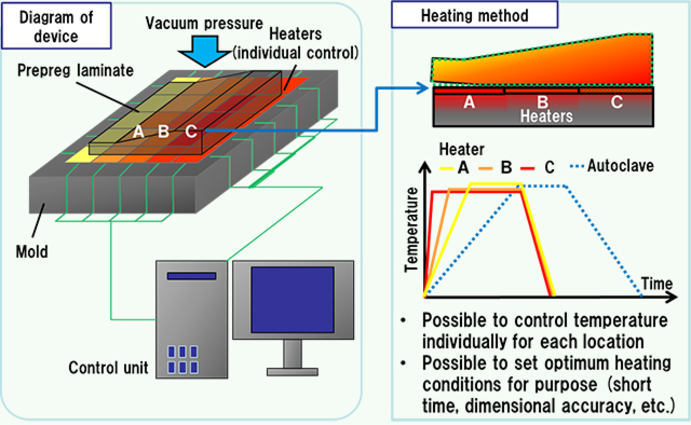April 3, 2018
Toray Develops New Out of Autoclave Technology for CFRP

Fabrication of Dimensionally Accurate Parts with Energy Savings
Toray Industries, Inc. (headquarters: Chuo-ku, Tokyo; President: Akihiro Nikkaku; hereinafter referred to as “Toray”) announced today that it succeeded in developing a new fabrication technology for Carbon Fiber Reinforced Plastics (hereinafter referred to as “CFRP”) that enables both improved dimensional accuracy and energy savings. Going forward, Toray will further mature this new technology and broadly deploy it to mainly aircraft applications that continuously demand higher productivity and more energy savings. Moreover this technology is anticipated to benefit automobile and general industrial applications as well, and will contribute to the development of CFRP materials.
CFRP is usually fabricated using an autoclave (high temperature and high pressure furnace) or an oven where prepreg (intermediate material in sheet form) is placed on a mold of predetermined shape and the resin in the prepreg is cured using heated air for fabrication. The conventional fabrication technology has disadvantage that requires long time for heating up and curing due to inefficient heat transfer of heated air and large heat capacity of the mold.
There is also dimensional accuracy problem of the part to be resolved particularly for a large, complex-shaped one with variable thickness from location to location. This is due to the difficulty in control of temperature distribution in the part, which could in turn generate variable residual stresses and sometimes significantly deform the part. Due to this, extensive labor work is required during final assembly of a multiple parts such as aircraft’s main wing by manually inserting filler materials called shims resulting in a longer assembly time than that for fabrication.
The newly developed fabrication technology provides a solution to the problem with a number of embedded sheet heaters on the mold’s surface such that each heater is individually controlled. The part under vacuum is heated effectively from direct contacts with the heaters, which could achieve energy savings. Controlling individual heaters and allowing optimum heat distribution at each location provides even residual stress throughout the fabricated part. As a result, the part can be fabricated as close to the original design with minimal dimensional inconsistencies and dimensions solving the aforementioned problem, and it is expected to reduce labor cost and duration of part assembly.
In order to effectively control this heating system, Toray carried out a joint research program with Ehime University and Tokyo University of Science to establish simulation technologies to predict part deformation and optimize heater temperature. Toray combined them into a program for designing heating conditions that would effectively minimize fabrication time and dimensional errors of the parts. Toray installed a prototype fabrication device and is currently conducting demonstration trials.
Depending on the part shape and dimension, it takes about nine hours to fabricate a large CFRP part for aircraft using conventional autoclaves and ovens, etc. The newly developed fabrication technology, on the other hand, is expected to reduce the fabrication time to about four hours. Moreover, this technology achieves about 50% energy saving compared to conventional fabrication methods as pressure and heating media such as heated air is not required. It is also expected to save time during assembly for correctional work using shims because of the improved dimensional accuracy for fabrication.
This article is based on results obtained from the Cross-ministerial Strategic Innovation Promotion Program (SIP) for “Structural Materials for Innovation” (managed by Japan Science and Technology Agency). The program is led by the Council for Science, Technology and Innovation (CSTI).
Toray has announced business expansion in growth fields and creation of new demand by developing new products as important tasks for the carbon fiber composite materials business in its medium-term management program “Project AP-G 2019,” launched in April 2017. Toray will continue to engage in developments for new products by enhancing performance of carbon fiber composite materials and improving user process capabilities.
Featured Image: Fig. Schematic diagram of the newly developed fabrication system